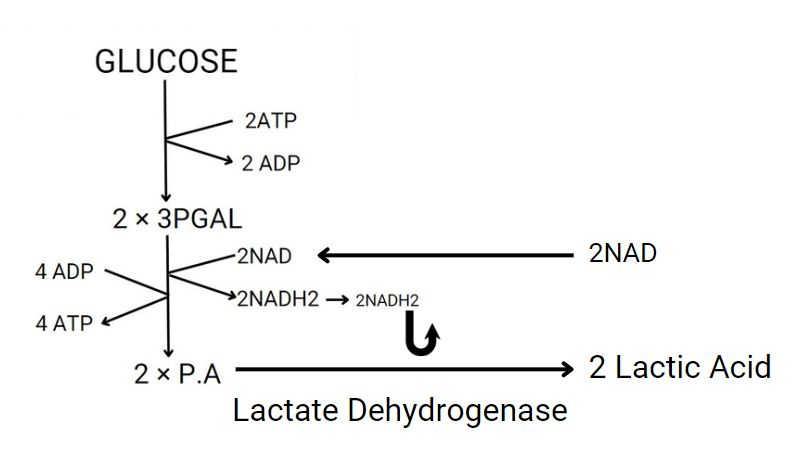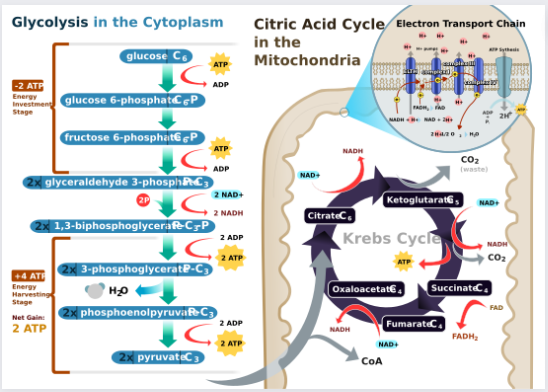In Aerobic respiration complete oxidation of respiratory substrate takes place which usually takes place in the presence of oxygen. It is carried out in 4 different steps :
- Glycolysis
- Link Reaction
- Kreb’s Cycle
- Oxidative phosphorylation
Aerobic respiration equation

Steps Of Aerobic Respiration
Glycolysis/EMP Pathway
- This pathway was given by 3 scientists : Embden, Meyerhof and Parnas, therefore it is called the EMP pathway.
- It is a universal pathway, glycolysis occurs in both aerobic and anaerobic organisms.
- Glycolysis takes place in the cytosol, it is a 10 step process in which 3 steps are irreversible & 7 steps are reversible.
- In this pathway, the glucose molecule is broken down into 2 pyruvic acid molecules.
- End product of glycolysis is a pyruvic acid molecule.
Link Reaction
- It is called link reaction because it links glycolysis with a Kreb’s cycle.
- Link reaction occurs in the mitochondrial matrix.
Kreb’s Cycle /TCA Cycle/Citric Acid Cycle
- This cycle was discovered by H.A Kreb and it is also known as the citric acid cycle.
- The first stable compound synthesis in this pathway is citric acid, consisting of 3 carboxylic groups therefore, it is also called Tricarboxylic acid cycle.
- It takes place in the mitochondrial matrix because all the enzymes are present in the mitochondrial matrix except Succinate dehydrogenase.
- 2 turns of Kreb’s cycle yields 6NADH₂ 2FADH₂ and 2 GTP (which all together. equivalent to 24 ATP), therefore each turn will yield 12 ATP.
- Substrate level phosphorylation yields 2 GTP equivalent to 2 ATP.
Oxidative phosphorylation
- NADH2 and FADH2 are re-oxidised to release H+ which is passed into the peri-mitochondrial space developing an H+ ion concentration gradient between the mitochondrial matrix and peri-mitochondrial space.
- Electron carriers arranged into 5 different complexes :
- Complex I – NADH2 dehydrogenase (FMN, Fe-S)
- .Complex II – Succinate dehydrogenase / FADH2 .
- Complex III – Cytochrome-C-reductase/Cyto b-c, complex(Fe-S).
- Complex IV – Cytochrome-C-Oxidase/Cyto a-a3 complex.
- Complex V – ATPase/ATP synthetase/F0-F1 particles.
- UQ and Cytochrome C are mobile e carriers.
- The ē carriers maintain an H+ ion concentration due to which proton gradient and electrical potential is developed, both together are called proton motive force.
- This PMF forces the H+ move out through theF0-F1 particles that generate energy which is fixed in the form of ATP.
- Per 2 H+ moving out generates 1 ATP.
- The Finale ē and H+ acceptor is Oxygen resulting in the formation of water.
- Cyanide blocks the flow of e from complex IV and therefore, aerobic respiration is stopped.
- In Pisum and Spinach, an alternate pathway is present, therefore they do not die in the presence of cyanide.
What is Anaerobic Respiration ?
- Incomplete or partial oxidation of respiratory substrate takes place.
- Less than 7% of the energy is fixed as ATP.
- Usually, it takes place in the absence or deficiency of Oxygen.
- Two types of Anaerobic Respiration are :
- Alcoholic fermentation.
- Lactic Acid fermentation.
Steps Of Anaerobic Respiration
Alcoholic fermentation

- The process of conversion of glucose into ethanol and CO2 is known as alcoholic fermentation and it takes place in yeast and some bacteria.
- Firstly, 1 molecule of glucose is converted into 2 molecules of PGAL using 2 ATP.
- Further, this PGAL molecule gets converted into pyruvic acid along with the formation of 4 ATP molecules and 2 NADH2, this process ( conversion of glucose into pyruvic acid) is known as glycolysis.
- After then, this pyruvic acid is further broken down into acetaldehyde using the enzyme pyruvate decarboxylase with the evolution of 2 molecules of carbon dioxide.
- Finally, acetaldehyde get converted into 2 molecules of ethanol (C₂H₅OH) And hence, there is a net gain of 2 ATP molecule in the whole process.
Lactic Acid fermentation

- This process takes place in lactobacillus bacteria and in skeletal muscles.
- One molecule of glucose is converted into 2 molecules of pyruvic acid with the formation of 2 ATP molecules and 2 NADH2 molecules and this particular process is termed as glycolysis.
- Further, pyruvic acid is converted into lactic acid using the enzyme lactate dehydrogenase
- Hence, this conversion of glucose into lactic acid is known as lactic acid fermentation.
Difference Between Aerobic And Anaerobic Respiration
FAQs
Which is aerobic and anaerobic respiration?
Respiration which occurs in the presence of oxygen is called aerobic and respiration which takes place in the absence of oxygen is known as anaerobic respiration.
What are the 4 types of aerobic respiration?
Four steps of aerobic respiration are :
- Glycolysis
- Link Reaction
- Kreb’s Cycle
- Oxidative phosphorylation
What is 36 ATP?
36 ATP produced in the citric acid cycle, 38 total molecules of ATP are created in aerobic respiration.





